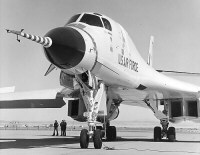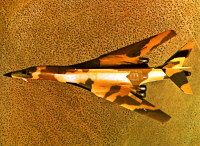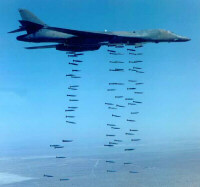B-1 Lancer History
The first B-1 made its first flight in the form of the Mach 2-capable B-1 prototype on 23 December 1974. The B-1 was cancelled in 1977, but the flight testing continued with four prototypes.
In 1981, the Reagan administration re-started the program for a long-range strategic bomber, by selecting Rockwell's proposal for an adaptation of the original B-1. In January 1982 Rockwell was awarded a full-scale development contract and a contract for the first aircraft, designated the B-1B. Compared to the earlier B-1 now designated B-1A, top speed was reduced to Mach 1.25, instead of relying on speed the focus was shifted to RCS reduction measures and defensive systems for survivability. A total of 100 aircraft was ordered for the USAF's Strategic Air Command (SAC). The B-1B production standard was first flown on 18 October 1984 and first entered service in July 1985 with . Initial Operational Capability was first achieved on 1 October 1986. The final B-1B was delivered on May 2, 1988.
The B-1B Lancer did not fly any combat missions over the Persian Gulf during the Gulf War against Iraq. The aircraft and the air crews were not prepared for the use of conventional weapons. However during the conflict the B-1B lancer and its crews were on constant stand-by to deliver nuclear weapons in case the conflict escalated.
The end of the Cold War resulted in SAC B-1Bs standing down from the nuclear alert duty on September 27, 1991. SAC itself was disestablished on June 1, 1992, and the B-1Bs were passed on to the newly formed Air Combat Command. The B-1B lost its nuclear role, however the only non-nuclear weapon cleared for the B-1B was the 500lb Mk.82 general-purpose bomb. A series of upgrades during the 1990s improved the B-1Bs conventional weapon capability, ultimately including precision and stand-off weapons.
Operation Desert Fox in 1998 saw the first combat missions for the B-1B, striking Iraqi targets with Mk.82 bombs. During Operation Allied Force in 1999, the B-1B dropped over 5,000 Mk.82 bombs. From 2001 onwards, the B-1B's operations over Iraq and Afghanistan included employing precision weapons. In 2007, the addition of the AN/AAQ-33 Sniper XR targeting pod boosted the B-1B's Close Air Support capabilities and enabling the bomber to self-designate targets. In 2011, B-1Bs also flew combat missions in Operation Odyssey Dawn against the Libyan regime. In 2014, the B-1B conducted strikes against Islamic State (IS) militants and IS-controlled targets in Iraq and Syria.

B-1A Prototype

Early B-1B

B-1B conventional weapons role


 Back to Index
Back to Index